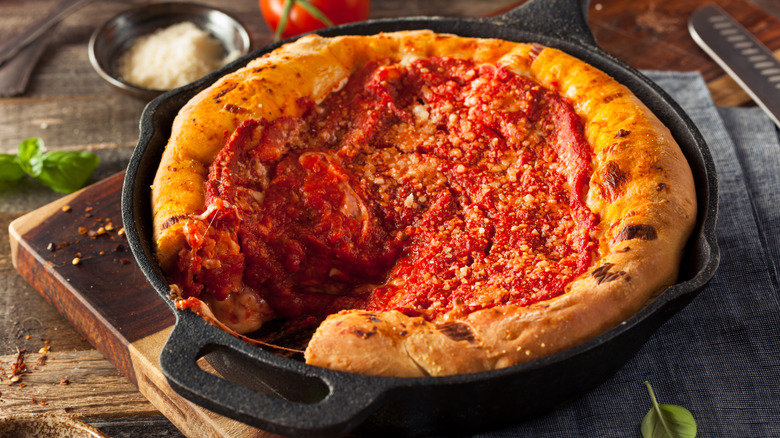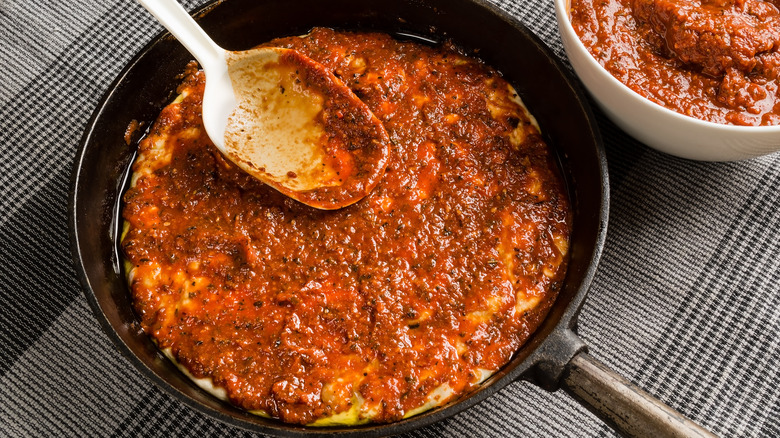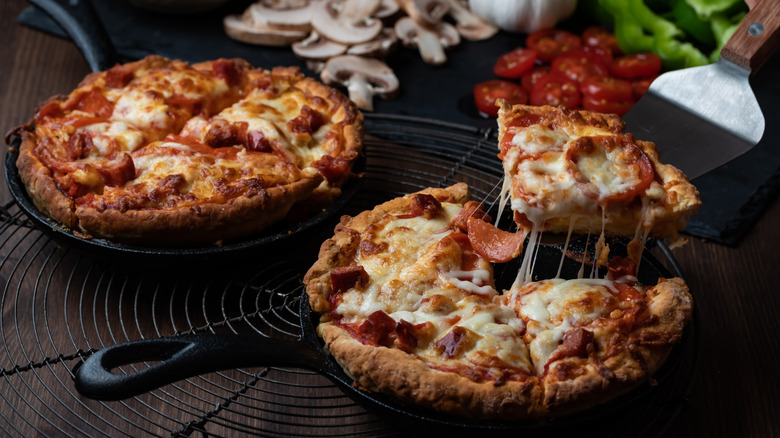Cook Your Pizza In A Cast Iron Skillet For Deep Dish Pies At Home
Deep dish pizza hits differently. It's not what you'd typically reach for if you're in the mood for a slice, but when you're craving the deep, regular pizza just won't cut it. The good news is that making deep dish is easier for a novice than a traditional pie, and a cast iron skillet helps ensure delicious results every time. To help get to the cheesy heart of the matter, Nicole Bean, owner of Pizaro's Pizza Napoletana in Houston, reveals what home cooks need to watch out for on their quest for the perfect deep dish pizza. From greasing the pan right and getting the perfect dough thickness to managing heat distribution so the crust cooks evenly, these tips make the difference between an average thick pie and one that has the magical combination of a crispy bottom on a fluffy crust.
The cast iron skillet helps give consistent results because it heats up quickly and more evenly than other pizza pans. With some practice, you can make other pies like the decadent stuffed crust and the simpler pan pizza; we also recommend ditching the practice of reheating leftover pizza in the microwave because short of a pizza oven, a cast iron skillet is the best option for breathing new life into cold 'za.
How to assemble and bake a deep dish pizza in a cast iron skillet
One of the many reasons deep dish pies are simple to make at home is because they require much less dough maneuvering. You don't have to toss it, stretch it, peel it off, or transfer it to a cooking surface. Instead, start with a room-temperature cast iron skillet, grease it (liberally), and press the ball of pizza dough onto the surface, shaping it with your fingers. Flatten the center of the dough along the bottom of the skillet, and then stretch the edges up along the sides of the pan. To ensure there are no soggy bits and everything cooks evenly, Bean advises forming the dough slightly thicker on the bottom than the sides.
The layers are reversed in a deep dish pie — first the cheese, then the toppings, then the sauce — then finally you're ready to bake. Because of the thicker dough, a deep dish pie takes more time to cook. However, be careful not to end up charring the top while you wait for the bottom to crisp up. "You do not have to use raw ingredients if you don't want to, but if ingredients are on top of the pizza there is a risk of overcooking during the bake," warns Bean. "Tin foil can help prevent burning in some cases, but usually a lower temperature for longer will prevent that."
Getting the perfect pizza crust with a cast iron skillet
A perfect deep dish crust is crispy and flaky on the outside and doughy on the inside. Common mistakes that result in a less-than-perfect crust are not greasing the pan sufficiently before spreading the dough on it, and not letting the pie bake for long enough. Regarding the latter, the only surefire way to know when the crust is at its best is to look for a deep, even golden color on the base. While a dark char or caramelization is more common on the crust of a pan pizza, you can get it on a deep dish if you decide to make it extra crispy.
While you might be tempted to use parchment paper to get a good browning, Bean recommends against this as it will result in trapped moisture. And if you find that the sides of your deep dish pizza are not getting sufficiently crisp, what you can do is press the dough even thinner against the sides of the skillet. Grilling frozen pizza is an option during the warmer months, but a cast iron skillet is year round and can easily handle reheating a leftover or frozen pizza. For this Bean recommends tossing in an ice cube and leaving on the lid to help the pizza retain moisture, similar to our ice cube hack for juicier burgers.


